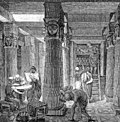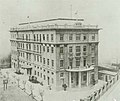Top Qs
Timeline
Chat
Perspective
List of destroyed libraries
From Wikipedia, the free encyclopedia
Remove ads
Libraries have been deliberately or accidentally destroyed or badly damaged. Sometimes a library is purposely destroyed as a form of culturicide.[1]


There are examples of libraries accidentally destroyed by human actions. Others were damaged by natural disasters like earthquakes, floods or accidental fires.
Library fires have happened sporadically through the centuries: notable examples are the destruction of the Library of Alexandria, the destruction of Library of Nalanda in India and the accidental burning of the Duchess Anna Amalia Library in Weimar, Germany.
Remove ads
Causes and prevention
Summarize
Perspective
In earlier times mildew was considered a major problem in many libraries, and so the emphasis on library design was to increase air flow by, for example, leaving openings under the shelves in adjoining floors. In a fire, particularly one that starts on any floor except the top level, the flames would be drawn from floor to floor by the air flow, leading quite easily to the destruction of a whole library rather than just a small part.[2]
Advances in technology have reduced the possibility of a library collection being destroyed by fire. These include water sprinklers, fire doors, freezers, alarms, smoke detectors, suppression systems, and emergency generators. Older libraries are usually altered by closing up air flow openings and installing fire doors, alarms and sprinklers. Air conditioning reduces the mold problems. These are all essential parts of new library design.
There is no recovery possible if a book is burnt, so it is accepted that it is better to put out the fire with water and then dry out the books. As mold destroys paper, the books are frozen until they can be dried. This process will damage the book but not destroy it, and the information will be intact.
To reduce the chance of damage from fire, or other causes, and decrease the time needed for recovery after a destructive event, libraries need a disaster management and recovery plan. This can be an ongoing process which will include professional development following updates in technology for key staff, training for the remaining staff, checking and maintaining disaster kits, and review of the disaster plan.
In addition, fire-safety investigations are periodically carried out, especially for historical libraries. The Library of Congress, for example, underwent a year-long inspection beginning in 2000. Before the Congressional Accountability Act of 1995, the Library of Congress and all Capitol Hill buildings were exempt from safety regulations.[3] Balancing historical preservation and contemporary safety standards proves to be a difficult task for "even a 12-year rehabilitation of LC completed in 1997 did not address many fire hazards".[4] After the Compliance Office inspection, however, the LC announced their wholehearted commitment "to achieving the highest level of safety possible" and "the Architect of the Capitol and Library of Congress will report their progress to the Office of Compliance every three months".[3]
Information technology is another reason for careful fire protection. With so many computers in libraries there "is a decrease in floor space and an increase in more compact and powerful computer systems" which generate more heat and require the use of many more outlets, increasing the number of potential ignition sources.[5] From as early as the 1950s the potential dangers of computer equipment, and the facilities that house them, were recognized. Thus, in 1962 the National Fire Protection Association began developing the first safety standards specifically applicable to electronic computer systems.[5] This standard is called NFPA 75 Protection of Information Technology Equipment. FM Global Data Sheet 5–32 is another standard providing guidelines to protect against not only fire, but also water, power loss, etc.[5]
Remove ads
Human action
Summarize
Perspective
Remove ads
Natural disasters
Fire
Remove ads
See also
Further reading
- The Bosnian Manuscript Ingathering Project – A call for Bosnian manuscripts ingathering
- Polastron, Lucien X. (2007) Libros en Llamas: historia de la interminable destrucción de bibliotecas. Libraria, ISBN 968-16-8398-6.
- Knuth, Rebecca. Libricide : the regime-sponsored destruction of books and libraries in the twentieth century. ISBN 0-275-98088-X
- Polastron, Lucien X. Books on fire: the destruction of libraries throughout history. ISBN 978-1-59477-167-5
- Civallero, Edgardo. When Memory Turns into Ashes... Memoricide During the XX Century Archived 2011-09-27 at the Wayback Machine. DOI.
- UNESCO. Lost Memory – Libraries and archives destroyed in the twentieth century
- Books on Fire: The Destruction of Libraries Throughout History. Lucien Xavier Polastron. Translated by John E Graham. Inner Traditions. ISBN 978-1-59477-167-5. ISBN 1-59477-167-7.
- Ovenden, Richard Burning the Books. London: John Murray[126]
Remove ads
References
External links
Wikiwand - on
Seamless Wikipedia browsing. On steroids.
Remove ads


















































